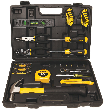Masonry walls can be a great addition to any landscape and a wonderful architectural element to any home. However, over time even those masonry walls that have been properly made and maintained can end up needing some repairs. Repairing masonry walls is a task that most, if not all, do-it-yourself enthusiasts can undertake. At least, they can if they follow these directions.
- Inspect the crack. When repairing masonry walls the first thing that you need to do is inspect the crack. The reason for this is that depending on the size or location of the crack you may need to contact a professional. For example if the cracks are actually in the bricks or stones, and not in the mortar then you will need to call a professional. Additionally, if the crack is long and continuous running for longer than two feet is another example of when to call a professional.
- Identify the cause. Once you have identified and inspected the crack you also need to try and identify the cause of the crack. The leading cause for cracks in masonry walls is moisture. This moisture can occasionally come from the exterior of the home, but sometimes it can come from cracks and leaks in your plumbing. Look at the plumbing that is near the crack and see if you can find any leaks. If you don't find and fix the cause of the potential leak, then your repair work will only be around for a short time.
- Call in a professional. In the event that you can't find the cause of the leak or the cause of the crack, you may want to call in a professional plumber or mason to take a look. Typically these experts can find the cause of your problems, and will charge a reasonable rate for that service. Additionally the professional can also give you an estimate on repairing the problem.
- Clean the crack. If you are going to be doing the repair work yourself, make sure that you first clean the crack as much as you possibly can. The best way to do this cleaning is by using some brushes and a hammer and chisel. The brushes will help you remove any dirt, grime, and loose debris that may be stuck in the crack. The hammer and chisel are what you use to smooth out the edges of the crack as much as possible so that you can have a nice even bond between the new mortar and old. You will need to apply the brush several times to the crack to ensure that you have removed as much of the debris as possible. Avoid using water as much as you can, though if you do make sure that you dry everything out completely before you begin applying the new mortar.
- Make and repair the mortar. Get some mortar from your local home improvement store, and read the instructions carefully. Follow the directions for making the mortar as carefully as you can, and then use a pointed masonry trowel to carefully apply the new mortar to the crack. Be as careful as you can so that you do not get any mortar onto the bricks themselves, and pack the mortar into the crack as much as possible so that there are no gaps.
Once you have finished applying the mortar, all you have to do now is clean things up and you are finished with your repairing masonry walls project. Keep in mind that even though you have repaired the masonry wall, you should still keep an eye on the area. The reason for this is that there may be other underlying causes for the cracks that you may not have been able to address. If you do notice the cracks reforming, then you may want to call in a professional to take a look and see what the problem is.
Author Bio
Lee Wyatt
Contributor of numerous Tips.Net articles, Lee Wyatt is quickly becoming a regular "Jack of all trades." He is currently an independent contractor specializing in writing and editing. Contact him today for all of your writing and editing needs! Click here to contact. Learn more about Lee...
Building a Home Playground
Anyone with kids and a little extra space in their yard knows the dream of having a home playground. These days, as long ...
Discover More
Get Rid of Dryer Grease Stains
For some reason even though you do everything right when washing your clothes, there are times when stains still seem to ...
Discover More
Cleaning a Baseball Cap
Baseball caps are one of the more popular hat choices in today's world, and as such a very common clothing accessory. ...
Discover More
More Home Improvement Tips
Finding Studs in Walls
Sometimes it's not easy to locate studs since they are mostly concealed behind plaster and other parts of the wall. While ...
Discover More
Repairing Cracked Plaster
It is a sad fact of life that plaster walls will become cracked, or have some fairly nasty holes after a while. Repairing ...
Discover More
Hanging Pictures with Style
Everyone can hang pictures on their wall, but not everyone can do it with style. Surprisingly hanging pictures with style ...
Discover More

Comments